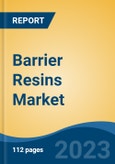Speak directly to the analyst to clarify any post sales queries you may have.
10% Free customizationThis report comes with 10% free customization, enabling you to add data that meets your specific business needs.
Global Barrier Resins Market is projected to grow at an impressive rate through 2028. In September 2022, the production volume of processed paper and cardboard in China was approximately 11.1 million metric tons.
However, the main challenges facing the market for barrier resins are rising prices, tight regulatory requirements, environmental regulations, and political standards. The demand for Barrier Resins is also anticipated to increase during the projected period as more application sectors choose sustainable packaging solutions due to regulatory restrictions.
The market for barrier resin is expanding as consumers desire food goods to last longer on the shelf. The demand for food goods with extended shelf lives has been rising. In food and beverage packaging, barrier resins seal out gases and protect items from moisture. They give the food a longer shelf life and better consistency, shield it from UV radiation and odors, and safeguard the food's nutrient content in the process.
Promising Demand from Packaging Industry
The global market for barrier resin is segmented into various application categories; however, demand for packaging from food and beverage is a promising driving factor. The packaging of food and drink items such as meat, fish, beer, wine, carbonated soft drinks, and canned milk is the main application of resin in this industry, which is the largest. Barrier resins are used in food and beverage packaging to protect vitamin content, increase shelf life, and improve food quality. They also stop odor and UV light penetration. There is a greater need for packaging due to growing urban populations, increasing demand for FMCGs, pharmaceuticals, and other consumer durables, and developing health and hygienic packaging issues. Due to its capacity to provide creative solutions to numerous packaging problems, the packaging is in high demand. IBEF adds that one of the most significant industries in the nation is food processing, which generates 70% of its revenue from retail and accounts for 32% of the country's overall food market while ranking fifth in production, consumption, and exports.
Growing Technological Advancement for Sustainable Development
Many plants, particularly coniferous trees, naturally contain resin. Resin is a viscous substance that often transforms into polymers in polymer chemistry. Such dense compounds can be naturally occurring, manufactured, or plant derived. Resins are often blends of organic substances. Creating more ecologically friendly barrier resins is one of the significant trends in barrier resin technology. This is because conventional barrier resins are made using potentially hazardous petroleum-based materials. Environmentally friendly barrier resins are produced in various forms, including those derived from plant-based substances. During the predicted timeframe, sustainability tendencies are expected to increase. Because of how plastic is made, sustainability will always be a challenge. However, recycling, and other development streams will help to balance out such sustainability concerns. For instance, the Coca-Cola European partners promised to recycle 50% of the plastic used in PET bottles by 2025 and to collect all packaging in Western Europe. In the European region, PepsiCo declared a long-term goal of using 50% recycled plastic in its bottles by 2030 and a short-term target of about 45% by 2025.
Market Segmentation
Global Barrier Resins market is segmented by type and application type. Based on product type, the market is divided into polyvinylidene chloride (PVDC), ethylene vinyl alcohol (EVOH), polyethylene naphthalate (PEN). Based on application, the market is segmented into food & beverage, pharmaceutical & medical, cosmetics, agriculture, others.
Market Players
Asahi Kasei Corporation, Chang Chun Petrochemical Co. Ltd., Du Pont de Nemours, Honeywell International, Inc., Mitsui Chemicals Inc., LG Chem, Teijin Limited, The Dow Chemical Company, The Nippon Synthetic Chemical Industry Co., Ltd, and Kuraray Co., Ltd are some of the key market players.
Report Scope:
In this report, Global Barrier Resins Market has been segmented into following categories, in addition to the industry trends which have also been detailed below:
Global Barrier Resins Market, By Type:
- Polyvinylidene Chloride (PVDC)
- Ethylene Vinyl Alcohol (EVOH)
- Polyethylene Naphthalate (PEN)
Global Barrier Resins Market, By Application:
- Food & Beverage
- Pharmaceutical & Medical
- Cosmetics
- Agriculture
- Others
Global Barrier Resins Market, By Region:
- North America
- United States
- Canada
- Mexico
- Europe
- France
- Germany
- United Kingdom
- Italy
- Spain
- Asia-Pacific
- China
- India
- Japan
- Taiwan
- South Korea
- Australia
- South America
- Brazil
- Argentina
- Colombia
- Middle East & Africa
- South Africa
- Saudi Arabia
- UAE
- Turkey
- Egypt
Competitive Landscape
Company Profiles: Detailed analysis of the major companies in Global Barrier Resins Market.
This product will be delivered within 1-3 business days.
Table of Contents
Companies Mentioned
- Asahi Kasei Corporation
- Chang Chun Petrochemical Co. Ltd.
- Du Pont de Nemours
- Honeywell International, Inc.
- Mitsui Chemicals Inc.
- LG Chem
- Teijin Limited
- The Dow Chemical Company
- The Nippon Synthetic Chemical Industry Co., Ltd
- Kuraray Co., Ltd








